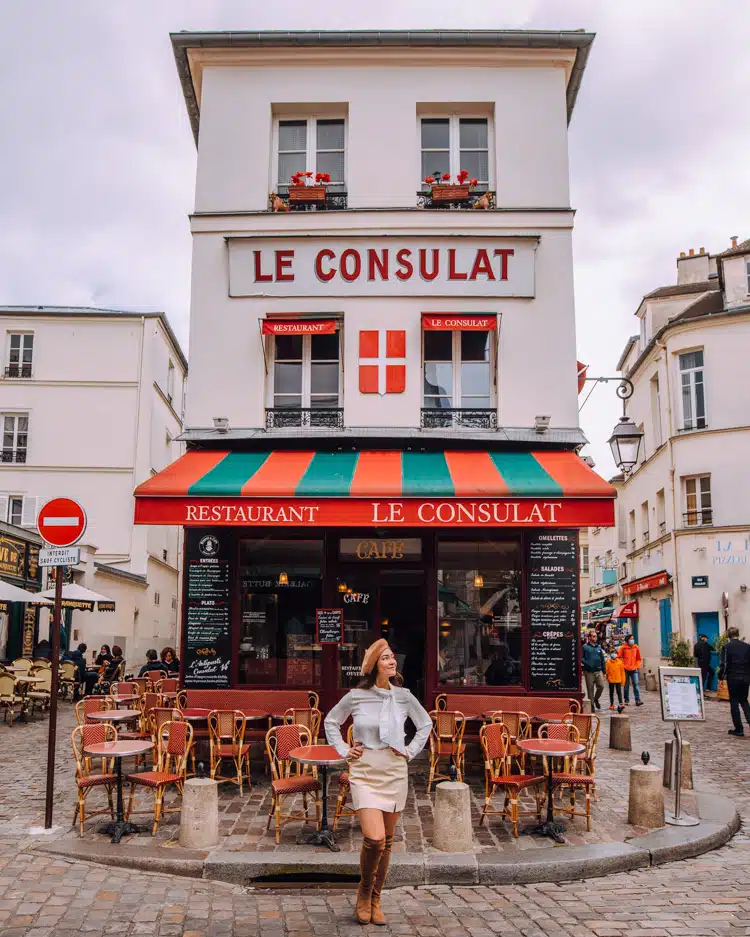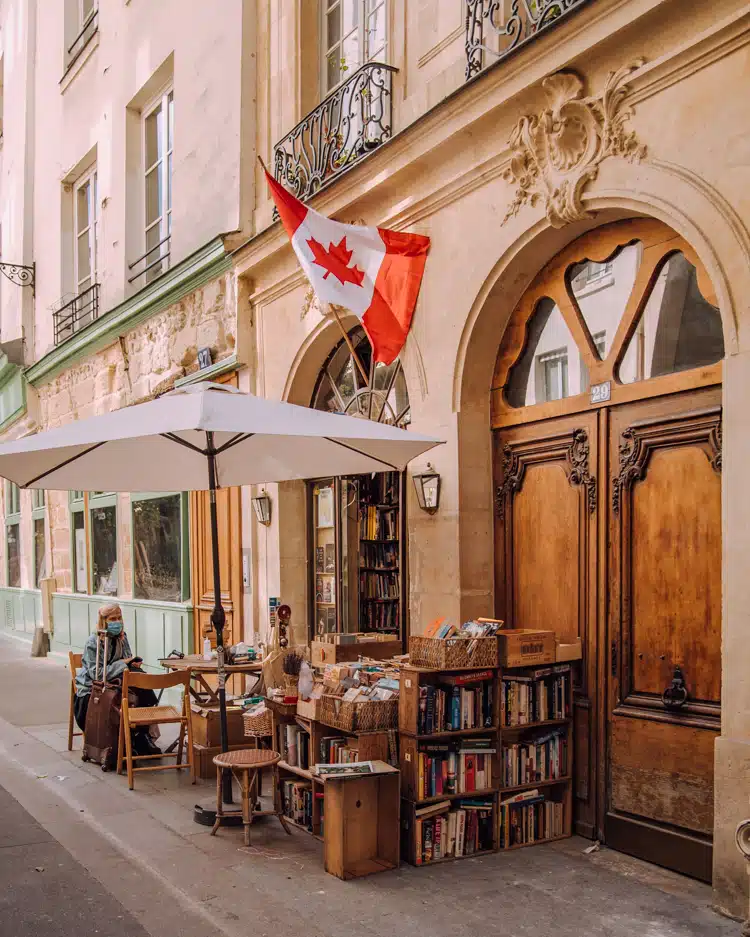
Whether you’re in Paris for a day or are visiting for a longer stay, you’ll have enough time to fall in love with this city. My heart especially fell for Montmartre. It’s simply one of the prettiest and most charming parts of Paris!
If you haven’t been, imagine a quaint French town with cobblestone streets and bright colors. If you’ve seen the movie Amélie, you know what I’m talking about (a lot of it was filmed there!).
Let’s get into everything you need to know for your visit to Montmartre!
What is Montmartre famous for?

Montmartre is famous for three things: churches, rebellions, and art. You can’t miss the towering white visage of Sacré-Cœur Basilica, a striking landmark that doubles as a scenic spot. Its hilly streets too, tempt you into taking photos non-stop. Quaint cafés, winding ivy, cobblestone paths, and the slow reveal of Paris’ skyline – Montmartre truly inspires art.
It’s no wonder that this charming, mythical and quirky neighborhood is known for its artistic history. From the mid-19th century, it has hosted a number of famous artists and writers. Montmartre exudes a unique, artsy vibe even today. In recent years, it has also gained a reputation for some of the finest nightlife in Paris.
What does Montmartre mean?
Originally named Mons Martis, which means “Mount of Mars”, Montmartre was later renamed to mean “Mount of the Martyr”. Many believe that the story of Saint Denis inspired this name change.
Who lived in Montmartre?
Montmartre was occupied by various religious communities, then milling villages; soldiers and revolutionaries fought over it for the bulk of the 19th century. Around the mid-1800s however, Montmartre became the haunt for writers and poets. Famous people who lived in Montmartre include Monet, Renoir, Picasso, Matisse, and more artists.
How old is Montmartre? When was Montmatre built?
Excavations and notable texts trace Montmartre’s origins to Gallo-Roman times. But it was only in 1134 that we started to see the Montmartre of today, when King Louis VI commissioned The Royal Abbey of Montmartre.
Famous Landmarks in Montmartre

There are some of the most famous and/or most photographed buildings in Montmartre:
- Sacré-Cœur (The Basilica of the Sacred Heart)
- La Maison Rose
- Le Consulate
- Moulin Rouge
- Place du Tertre (artist’s gallery)
- The sinking house
Is Montmartre worth visiting?

Montmartre is definitely worth visiting! Not only is it historically significant, but many of its quirky cafés and well-loved stores also remain. While art and history enthusiasts would fall in love with its rich culture, anyone would appreciate its eclectic attractions. The views from Sacré-Cœur alone also make the trip worth it.
How much time do you need to explore Montmartre?

If you’re visiting Paris for a few days, dedicate one full day to exploring Montmartre. This includes strolling through its streets, stopping by museums, touring Sacré-Cœur, and resting your feet at one of its charming cafés. Stay for a cabaret show in the evening for a complete Montmartre experience.
Is Montmartre expensive?
Montmartre used to be cheaper than Paris proper, hence the plethora of struggling artists moving in. Depending on what you decide to do, your Montmartre visit could be extremely cheap or rather costly. Quirky, cozy cafés and restaurants keep your budget low; you can also spend the entire day exploring the streets for free. However, certain attractions such as a night show at Moulin Rouge could start at 87 euros.
We suggest checking entrance fees (maybe even individual restaurant costs) when planning your itinerary.
Where is Montmartre located?

Situated in the 18th arrondissement of Paris, Montmartre is on the right bank of the Seine River. The neighborhood is relatively central, close to major attractions such as Arc de Triomphe, Eiffel Tower, and Louvre Museum. It borders the northern suburbs and red-light district of Pigalle.
You can easily access it via lines 2, 4, or 12 of the Paris metro.
How far is Montmartre from the Eiffel Tower?
Just 5.6 kilometers away, Montmartre is extremely close to the Eiffel Tower! You can easily close the distance by car, metro, bus, bicycle, or even a slow meandering walk.
How to get from Montmartre to the Eiffel Tower

There are several ways to get from Montmartre to Eiffel Tower:
- Metro – Take line 2 from any of the 4 Montmartre stations (Blanche, Pigalle, Anvers, Place de Clichy) and upon reaching Charles de Gaulle-Etoile, switch to metro line 6. Get off at either Bir Hakeim or Trocadero station. The journey takes approximately 20 minutes.
- Bus – Bus 30 runs directly from Montmartre to Eiffel Tower; get on at either Pigalle, Blanche or Place de Clichy and disembark right in front of the tower.
- Car/Taxi – The average journey runs from 18 to 40 minutes depending on traffic, but it can be convenient if you’re travelling in large groups.
- Bicycle – A direct bike ride takes around half an hour, but it’s a great opportunity to explore along the way.
- Walking – Brisk walkers can make it from Montmartre to Eiffel Tower in less than 1.5 hours; you can also take your time and stroll by the Opera, the Louvre and along the Seine.
Can you see the Eiffel Tower from Montmartre?
Yes! Montmartre has some of the best Eiffel Tower views in Paris thanks to its hilly nature. Rue Norvins and Rue Jean-Baptiste Clement; Rue Azais and Square Nadar; and Passage de la Sorciere are all lovely scenic spots. And, of course, you can see the tower from the Sacre-Coeur. Note that you may want to bring a zoom lens, as the tower is pretty far away.
Is Montmartre a good place to stay in Paris?

If you’re looking for somewhere convenient but quiet, Montmartre is right up your alley. Its proximity to major attractions is a huge pro; there’s plenty to see within walking distance. Its hilly terrain also offers amazing views over the city. When it comes to Parisian charms, we give it an A+.
However, Montmartre’s lively nightlife isn’t for everyone. Those staying close to the bars and pubs may find it too noisy at night.
Hotels near Montmartre Paris
Boutique hotels set in historical buildings are the trend in Montmartre and surrounding arrondissements. Here are some beautiful accommodations:
- Hotel Maison Mere – Nestled in the 9th arrondissement is a quirky, vibrant hotel. Hotel Maison Mere doesn’t just offer character-filled rooms with comfortable amenities; it also functions as a bar, co-working café, artistic hub and festive space. We stayed here (our balcony is pictured above) and it was about a fifteen-minute walk to Montmartre.
- Maison Souquet – A 5-star boutique hotel opposite Moulin Rouge, Maison Souquet boasts 20 rooms that are named after famous courtesans. From its elite amenities, you’d never guess it used to be a brothel.
- Hotel Rochechouart – ‘Moody’ best describes Hotel Rochechouart in the 9th arrondissement. Featuring a rooftop bar, sophisticated restaurant and close proximity to Palais Garnier opera house, it’s an accessible stay with boutique service.
- Hotel Declic – Just 15 minutes away from Sacré-Cœur, Hotel Declic is convenient but away from tourist traffic. Distinctive photographs decorate each guest room.
- Hotel Monsieur Aristide – Airy, stylish rooms characterize Hotel Monsieur Aristide. This 3-star stay is set on a tranquil street just 11 minutes away from Sacré-Cœur. Best yet, is the private garden access.
Is Montmartre safe?

Generally speaking, Montmartre is a safe neighborhood. Police presence is high; in both uniform and plainclothes. It’s also touristy during the day and night due to its proximity to Pigalle (the red-light district) so confrontational crime is highly unlikely.
Pickpockets are your biggest worry as they’re drawn to crowds. As long as you’re aware of your belongings, however, you should have a smooth day out in Montmartre.
Is Montmartre safe at night?
There’s enough of a tourist presence at night to prevent any bigger crimes, but expect the usual risks that come with a lively nightlife district. This includes drunks and pickpockets. Do what you normally would to stay safe at night, such as traveling with a friend and avoiding empty, dark alleyways.
Best places to eat in Montmartre
There’s no shortage of good places to eat in Montmartre, but start with these local favorites:
Vrai Paris

Vrai Paris is an Instagram dream and its food is undeniably delicious. Order their signature lamb shanks or try their equally loved steaks and risotto.
Le Petit Moulin Montmartre
This French bistro and wine bar serves mostly Parisian fare, but charcuterie platters are available for lighter snacking. Its wine selection is highly praised as well.
Le Consulat

Many of the greats have visited Le Consulat Café; understandably so if you’ve seen its vintage charms. Their Steak au Poivre comes highly recommended; crepes, salads, and omelets are great breakfast choices too. If you miss lunch hour, order an espresso and sit out on the terrace.
Sacree Fleur
Meat is worshipped at Sacree Fleur. From rump steak or beef rib to tartare, this meat-based menu is incredibly varied. Alternative meat options include classic French starters like frog’s legs and snails.
Le Maison Rose

The iconic pink house opened as a restaurant in 1908. Not only is it pretty, but it’s intimate, well-priced and with amazing Polpettes. The traditional French menu offers a signature veal.
Soul Kitchen
Looking for somewhere cozy with vegetarian options? Soul Kitchen offers delicious soups, pizzas, and couscous; dessert serves homemade pastries and cupcakes.
Top ten things to do in Montmartre
From massive, sky-high landmarks to hidden courtyards, Montmartre has a startling variety of attractions on offer.
1. Sacré-Cœur

Perhaps the most famous attraction in Montmartre, Sacré-Cœur is on every Paris to-do list. Take the funicular up the hill (it’s an attraction on its own) and admire the grand exterior before exploring inside. Climb up the dome for panoramic views over the city. We’ll go a bit more in-depth about the Sacré-Cœur in just a bit.
2. Place de Tertre

Place de Tertre is very touristy, but charming enough to make you forget about it. Countless artists gather out here; it’s where you go to get your portrait or caricature done. It’s worth looking around!
3. Moulin Rouge

Expensive but worth every penny (if this is your type of experience), Moulin Rouge is a world-renowned cabaret. Seek out its iconic red windmill and buy a nightly show. This dance hall has been perfecting its performances since 1889. (Moulin Rouge is actually on the outskirts of Montmartre, but is still partially considered to be in the neighborhood.)
4. Salvador Dali Museum
Espace Dali features a permanent exhibition of 300 Dali masterpieces, ranging from paintings to sculptures and initial sketches. We highly recommend it for any Dali fans!
Other popular museums in the area include Musée d’Art Naïf Max Fourny, Musée de la Vie Romantique, and of course, Musée de Montmartre.
5. Rue des Martyrs
This sloping avenue embodies Montmartre’s bohemian vibes. Second boutiques, bookshops, fresh flowers, food vendors, the scent of freshly baked pastries – you can loiter around Rue des Martyrs for hours.
6. Montmartre Cemetery
Cemeteries can be beautiful under the right light. Since 1825, many prominent French artists rest in Paris’ third-largest cemetery: Emile Zola, Dalida, Alexandre Dumas, and Degas to name a few. Located on the outskirts of old Montmartre, this quiet memorial site is a great break from the usual touristy fare.
7. Le Clos Montmartre
The oldest and last working vineyard in Paris, Le Clos Montmartre is tiny but bursting with history. Visit this lovely place behind Musee de Montmartre for a side of Montmartre that few get to see. Time your visit right to experience its annual harvest party.
8. Mur des Je T’Aime

Whether you’ve cemented your romance or are taking your time in finding true love, snap a photo at Mur des Je T’Aime. 600 tiles of I Love Yous span the wall, expressing this universal sentiment across 250 languages.
9. Look for the windmills
Montmartre may no longer be farmland covered in windmills, but the remnants are quite a sight!
10. Trace the footsteps of famous artists

From Renoir to Van Gogh to Picasso, Montmartre is immortalized in many artworks. Art buffs and art historians would love these old haunts: 49 Rue Gabrielle, Picasso’s first studio; Bateau-Lavoir, the meeting place of artists throughout the 19th and century; and the 1860 Lapin Agile, a cabaret loved by the artists.
Why is the Sacré-Cœur famous?

The second most-visited monument in Paris, Sacré-Cœur holds both cultural and political significance. Not only was this Roman Catholic Church built and dedicated to the Sacred Heart of Jesus; it was also meant to represent national penance after France’s defeat in the Franco-Prussian War and the consequent French Revolution.
Of course, the Sacré-Cœur is also famous for its beauty! From its Romano-Byzantine structure to the sloping dome on top, you’ll be snapping photos left and right.
How many steps is the Sacré-Cœur?
While there’s a funicular up to the base of Sacré-Cœur, you have to walk up the famous Dome for those spectacular views. There are 300 steps up to the top!
Comparing Montmartre to other popular Parisian areas
Whether you should visit Montmartre or its Parisian counterparts depends on what you’re looking for. Montmartre is perfect for young adults seeking artistic spaces and partying venues; it’s also for anyone who likes chasing history through quiet gardens and statement architecture.
Montmartre or Marais

Compared to Montmartre’s spread of attractions, Marais is a concentrated dose of culture. Also known as SoMa, this district is teeming with hip boutiques, galleries, and gay bars.
From the stunning Place des Vosges square to Pompidou Centre to elegant arcades, Marais is more “on trend” than nostalgic Montmartre. People and vibrance make the Marais what it is, while architecture and cobblestone streets make Montmartre what it is.
La Marais is also more central; it’s very close to Notre Dame and is bordered by the Seine.
Montmartre or St. Germain

Like Montmartre, St. Germain is known for its literary and artistic residents. It’s the artsy and poetic Paris of your dreams, teeming with small boutiques and literary flair.
If Montmartre celebrates art with a few nights of cabaret, St. Germain makes you admire that painted door and its detailed, golden fittings. It’s also located right by the Seine, in a much more central location.
Montmartre or Latin Quarter

Students and bistros make up the bulk of the Latin Quarter, imbibing it with a much more youthful atmosphere. Home to Sorbonne University and countless bookshops set in historical buildings, the energy is more frenetic compared to Montmartre’s laidback nature.
The Latin Quarter is also extremely family-friendly, encompassing the botanical garden Jardin des Plantes, the National Museum of Natural History, and the iconic Pantheon.
In conclusion…

Montmartre is a vibrant and charming part of Paris where you can step back in time and feel the love in the air!
This part of Paris, with all of its charm, easily became my favorite area in Paris. I hope you get that same feeling after visiting!
So go check it out for yourself. It has a wonderful retro vibe that you don’t *quite* get anywhere else in Paris.
Have you been to Montmartre? Comment any other suggestions you have for the Montmartre area below!
And if you’re planning a trip to Paris, here are some more posts you might enjoy:
Happy exploring,
Jasmine













10 Responses
My favorite part of Paris.
It’s my favorite part, too!! Montmartre is just so beautiful!!
Hi Jasmine Where are you when posing through arch towards the Eiffel Tower?
Hi Maribel! That is from the top of the Sacre-Coeur! It’s one of my favorite places in all of Paris!
It’s my favorite place in Frence!!Great content!!
I’m glad to hear it! I love Montmartre so much; it’s definitely my favorite area of Paris!
Absolutely amazing content!!
Thank you so much, Sarah!
Thank you, Madam ! Great style of you in romantic and wonderful Paris, Montmartre !
Thanks for the kind words!